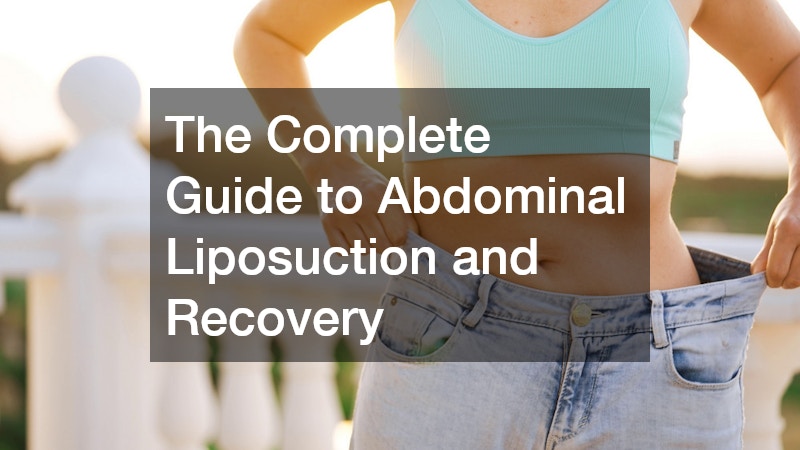Abdominal liposuction is one of the most popular cosmetic procedures used to shape and contour the body by removing excess fat from the abdomen. Whether you’re considering this procedure for cosmetic reasons or as a step toward a healthier lifestyle, understanding the process and recovery involved is crucial. This guide will walk you through everything you need to know about abdominal liposuction, from the initial consultation to the final stages of recovery, ensuring you are thoroughly informed and prepared.
Understanding Abdominal Liposuction
Abdominal liposuction is a surgical procedure designed to remove stubborn fat deposits that have not responded to diet and exercise. Small incisions are made, and a cannula is inserted to suction out unwanted fat.
It is particularly effective for people seeking specific contouring of the abdominal area. Candidates should be in good health and have realistic expectations. While liposuction can significantly improve body shape, it is not a substitute for weight loss.
Different techniques are available, such as tumescent, ultrasound-assisted, and laser-assisted liposuction. Tumescent liposuction involves injecting a fluid mixture to ease fat removal and minimize blood loss. Ultrasound-assisted liposuction uses sound waves to liquefy fat, while laser-assisted liposuction uses laser energy to break down fat cells. The best option depends on the patient’s health and goals, which can be determined through consultation with a qualified plastic surgeon.
Like any surgery, abdominal liposuction carries risks such as infection, reaction to anesthesia, uneven contours, or scarring. However, advancements in techniques have reduced serious complications when performed by a skilled surgeon. Being open about your medical history and medications helps minimize risks. Accepting these considerations is essential before moving forward.
Preparing for Your Abdominal Liposuction Procedure
Preparation is key to a successful outcome. A consultation with your plastic surgeon will involve reviewing your medical history, evaluating your abdominal area, and discussing your expectations. This is the time to ask questions and ensure you understand the process. You may be asked to stop certain medications or supplements in advance.
Patients are usually encouraged to reach a stable weight beforehand, as fluctuations can affect results. Maintaining a healthy lifestyle with balanced nutrition and exercise can improve recovery. It’s also important to arrange post-operative support at home since mobility may be limited in the first days. Preparing your home by setting up a comfortable recovery area can make the process easier.
Psychological readiness is just as important as physical preparation. Candidates should understand that liposuction removes localized fat but does not prevent future weight gain or address obesity. Approaching the surgery with a healthy lifestyle mindset will help maintain long-term results.
What to Expect During the Recovery Process
Recovery varies depending on the individual and the extent of the procedure. Swelling, bruising, and discomfort are common for several weeks. Pain can usually be managed with prescribed medications and compression garments, which also reduce swelling and support healing. While strenuous activities should be avoided for several weeks, many patients return to work and light activity within a week. Closely following post-operative instructions ensures safer recovery.
Nutrition and hydration play an important role in healing. A diet rich in vitamins and minerals supports tissue repair, while proper hydration helps flush toxins and lowers the risk of complications. Following dietary guidance from your surgeon can speed recovery and improve final results. Monitoring your body’s response and reporting any unusual changes to your healthcare provider is vital.
Long-term outcomes depend on lifestyle. While liposuction permanently removes fat cells, weight gain afterward may show in untreated areas. A healthy diet and consistent exercise are critical for maintaining results. Follow-up appointments allow your surgeon to track your progress and address concerns, supporting lasting success.
Weighing the Benefits and Considerations
Abdominal liposuction offers benefits such as improved contours and greater self-confidence. However, weighing these against the risks and recovery requirements is essential. Success depends on your overall health, realistic expectations, and dedication to maintaining results. Choosing an experienced surgeon also greatly influences safety and effectiveness.
By fully understanding what abdominal liposuction entails, you set realistic expectations for both the procedure and recovery. Whether your goal is to enhance appearance or take a step toward a healthier lifestyle, knowledge and preparation are crucial. The collaboration between surgeon and patient, combined with a commitment to a healthy lifestyle, can produce highly satisfying outcomes.
Abdominal liposuction can be life-changing, but it requires thoughtful consideration. Balancing the potential benefits with the realities of surgery and recovery helps ensure the best experience and results. Prioritizing your health, safety, and long-term satisfaction is key to embracing this opportunity for self-improvement and renewed confidence.





